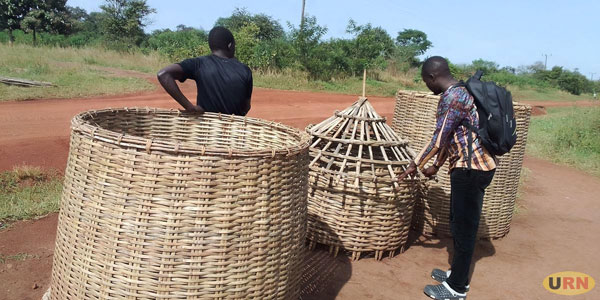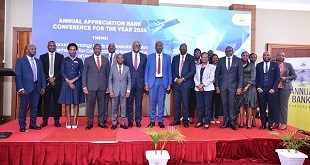
Makers of beehives are only using bamboo now, because most trees have been cut down for charcoal.
Lamwo, Uganda | THE INDEPENDENT | Denis Okello started recognizing the bamboo expanse in Lamwo district as his lifeline when he was only 17- years old. Having lost his parents during the Lord’s Resistance Army-LRA war and spent most of his early years in the Internally Displaced Persons camp.
Okello never had the chance to attain any formal education. “When the IDP camps closed, the bamboo forest became my classroom and the bamboo stems were the materials for my craft lessons,” says Okello, now 34. After a year of perfecting his crafting skills, Okello a resident of Agu Village, Dibolyec Parish Lokung East Sub-County started making chicken coops for sale.
Okello had dreams of being a poultry farmer since he was 15 years old, which is why he dedicated a year to teaching himself to make chicken coops. As Okello struggles to save enough money to start a “sizeable” poultry farm, he has diversified his craft business, to making granaries, and seedling fences to broaden his income base. Each seedling fetches between 3,000-5,000 Shillings, a granary is sold at between 30,000-50,000 Shillings, and each chicken coop ranges from 10,000-20,000 Shillings.
However, there have been more harvesters of bamboo for the past five years, says Okello who started earning a living from the bamboo forests 16 years ago. “Wherever I went to the forest years back, I rarely encountered anyone,” Okello says, adding “I feel like my livelihood is under threat given the increasing number of harvesters of bamboo.”
Okello notes that beehives were made from palm trees and big tree trunks. However, makers of beehives are only using bamboo now, because most trees have been cut down for charcoal. Oxythenanthera Abyssinica or lowland bamboo is one of the versatile bamboo species that are indigenous to Africa.
The durability of bamboo makes it useful in construction, paper, furniture, and fabric making. It is also used to make biofuels, charcoal, curtains, mats, toothpicks, and incense sticks. In Uganda, the lowland bamboo is endemic in a few districts in northern Uganda and the West Nile sub-region and takes between 2 to 3 years to mature.
It is estimated that the bamboo forest in Lokung East sub-county covers between 50 to 65 square kilometers of the hilly ranges bordering Uganda and South Sudan. The bamboo forest covers an estimated 30 square kilometers, 45 square kilometers, and 25 square kilometers in Padibe, Palabek, and Agoro sub-counties, respectively. As craftsmen like Okello are mainly concerned about their sustenance, George Obol Otira, the chief of the Padibe clan, thinks the overexploitation of bamboo presents a graver problem.
Otira recalls that before the Lord’s Resistance Army Rebels, the locals harvested only mature bamboo, mainly for roofing their huts, and occasionally for making chicken granaries. But now, its use has increased in the district and beyond; to include the making of entertainment shades, fences, pens, furniture, handicrafts, musical instruments, carvings, and drying racks.
Otira says the high demand for bamboo in other districts has forced many to harvest immature bamboo, something he says has reduced the density of the forests and led to encroachment. “The locals harvested only mature bamboo and those that had fallen down already, but business-minded people now harvest indiscriminately, Otira said.
Otira observes that bamboo forests help in controlling soil erosion, and retaining moisture, which explains why farmers from districts such as Kitgum, Gulu, and Pader go to farm in Lamwo. “That is why you hear that many farmers looking for farmland near the border because the land is fertile, has high moisture content, and receives adequate rainfall.”
Ecologists contend that bamboo forests also host wildlife, feed birds, and can sink twice as much carbon as rainforests, reducing greenhouse gas effects and slowing down global warming. Otira suggests as northern Uganda struggles to curb deforestation and its effects, sub-counties and clan leaders should enact bylaws to maintain the current bamboo forests. “Since it is attracting many business people, leaders should enact a law to control its harvest,” he says, adding that the bamboo will help generations, as many districts don’t even have them.” Timothy Jokkene, a farmer in Agago, says mass bamboo growing would mitigate depletion, save the environment, and make families and administrative units earn income through carbon credit.
Jokkene explains that if a household plants 2 and a half acres of bamboo, they would earn from harvesting thirty percent of it, and get carbon credit from the 70 percent left to purify the air. The Corporate Credit Institute defines a carbon credit as a tradable permit or certificate that provides the holder of the credit the right to emit one ton of carbon dioxide or the equivalent of another Green House Gas-GHG.
Each carbon credit (1000 kilograms of carbon dioxide or GHG) goes for between 40 dollars to 80 dollars on average. “If 10,000 households plant two and a half acres each, they would get 4 million dollars (approximately 15.1 billion shillings) each year,” Jokkene explained.
According to Jokkene, plane manufacturers and oil companies are known to be the greatest emitters of GHGs, and the reason they want low emitters of GHGs plant trees for money to filter the air. “If you plant trees and they profile you, you get your money annually. This is better than rivaling over land and selling them cheaply or losing some to land grabbers,” he argued.
In 2002, Uganda joined the International Bamboo and Rattan Organization, INBAR, a global group with 48 countries focused on developing the bamboo industry. Together with the Ministry of Water and Environment-MWE, INBAR launched the 2019-2029 Uganda National Bamboo Strategy and Action Plan.
The strategy outlines the desire to plant 70,000 hectares and restore 15,000 hectares of bamboo between 2019 and 2024, while between 2025 and 2040 the policy predicts more than 230,000 hectares of planted and 60,000 hectares of regenerated bamboo.
The MWE estimates that planting and managing bamboo will contribute an estimated 15% towards Uganda’s goal of restoring 2.5 million hectares of forest landscape by 2030. However, four years after the strategy was launched, mass implementation is yet to be seen. Few nursery bed operators seem to have taken interest in benefitting from the strategy.
A 2023-2035 report by the Food and Agriculture Organization, indicates that there are only four (4) certified seedling nurseries dedicated to nurturing bamboo seedlings countrywide, against 145 certified nurseries for assorted trees and fruit seedlings.
Sisto Ocen, the Lamwo district chairperson, acknowledges that many people are now harvesting the bamboo for sale in several districts in northern Uganda and beyond, after paying loading fees. Much as the cultural leaders think the bamboo expanse is at risk of depletion due to uncontrolled harvest, Ocen believes that the forest is non-depletable, and says the district has no plans to plant more.
“Lamwo doesn’t have any plans to plant bamboo because the bamboo we have here are so many and grow naturally,” he said.
*****
This story was produced with financial support from the American Jewish World Service (AJWS) through the Northern Uganda Media Club (NUMEC).
 The Independent Uganda: You get the Truth we Pay the Price
The Independent Uganda: You get the Truth we Pay the Price


